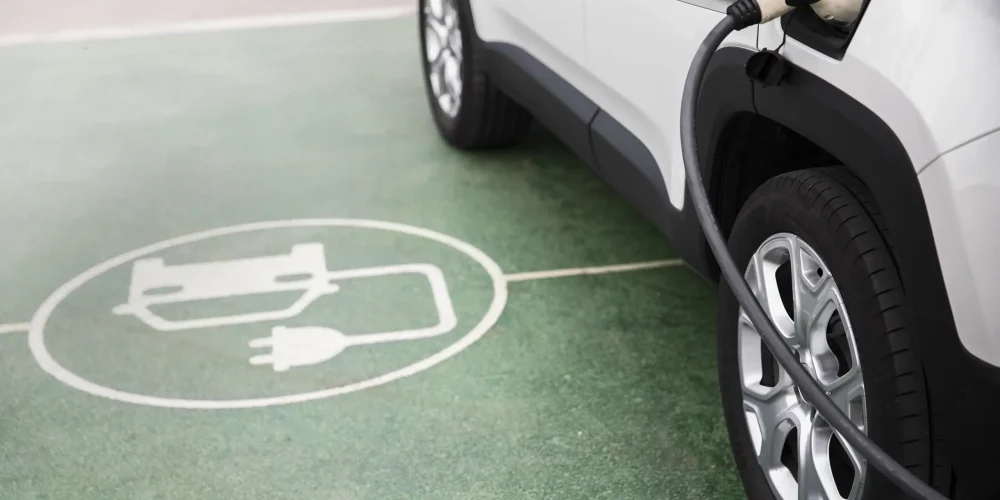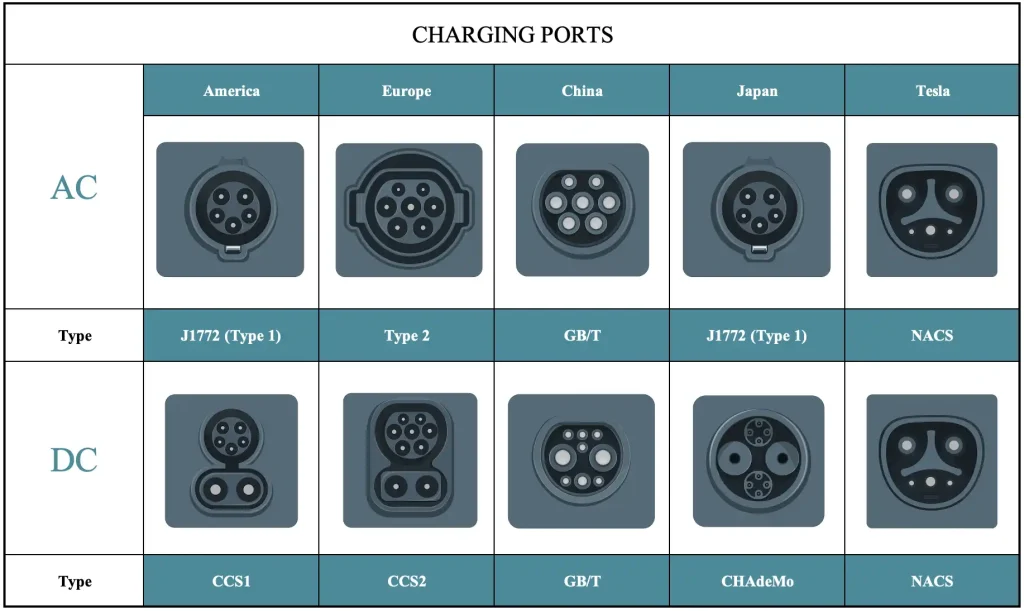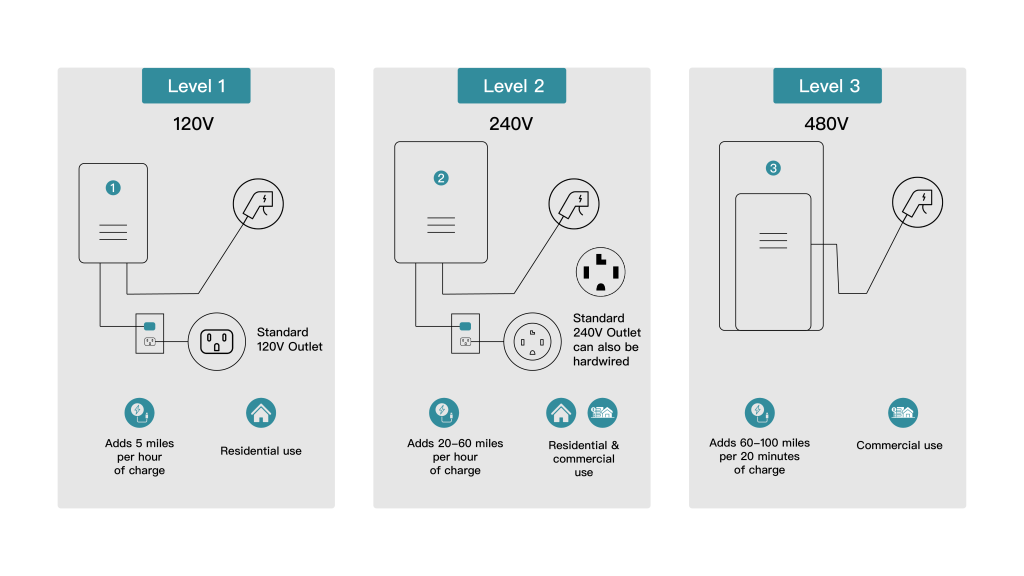
As electric vehicles (EVs) grow in popularity, understanding the right EV charger is essential for maximizing your vehicle’s potential and convenience. In this comprehensive guide, we’ll explore key insights into EV chargers, including standards, charging levels, installation, and choosing the best charger for your needs.
1. Overview of EV Chargers
EV chargers are critical for powering your electric vehicle. They vary significantly in terms of power levels, connector types, and charging speeds. The global market for electric vehicle chargers is expanding rapidly due to the rising adoption of EVs and the push for sustainable energy. Understanding the fundamentals of EV chargers is crucial for selecting the right one based on your needs.
How Many EV Charger Standards Are There?
EV charger standards differ by region and charging type. Some countries, such as U.S. and the Japan, share AC standards, while others have developed unique systems. For a more detailed exploration of these standards, visit our Complete Guide to EV Charger Standards.
1. EV Charger Standards by Region:
Different countries and regions have adopted specific EV charging standards based on local infrastructure and technological developments. Below is an outline of the major charging standards and the regions where they are predominantly used:
a. CCS (Combined Charging System)
CCS was developed by North America (CCS1) and Europe (CCS2) to integrate both AC and DC charging interfaces. However, due to historical and infrastructure differences, the AC portion uses SAE J1772 (Type 1) in the United States and Type 2 in Europe.
b. Type 1 (SAE J1772):
Developed by the Society of Automotive Engineers (SAE), this single-phase AC charging standard is used in North America and Japan. In the U.S., it’s commonly called J1772, while internationally, it’s known as Type 1 for distinction.
c. Type 2 (IEC 62196-2):
Created by the International Electrotechnical Commission (IEC), this standard supports three-phase AC charging and is widely used across Europe, also compatible with DC fast charging.
d. GB/T:
China’s national standard, supporting both AC and DC charging, primarily used in the Chinese market.
e. Tesla NACS:
Tesla’s proprietary charging standard used mainly in North America, supporting both AC and DC charging.
f. CHAdeMO:
A Japanese-developed DC fast charging standard, widely adopted in Japan and some international markets.
2. EV Charger Standards by Type (AC/DC):
In addition to regional differences, EV charging standards can also be classified based on the type of power they use: AC or DC. AC is typically slower, suitable for home charging, while DC is faster, more common at public charging stations.
a. AC Charger
AC chargers are typically used for slower charging, making them ideal for home or workplace charging setups.
- Type 1 (SAE J1772): Widely used in North America and Japan.
- Type 2 (IEC 62196-2): Common in Europe, Australia, and parts of Asia.
- GB/T AC: Used predominantly in China.
b. DC Charger
DC chargers are designed for rapid charging, often found at public charging stations where fast charging is a priority.
- CCS1: Used in the U.S., Canada, and South Korea.
- CCS2: Used in Europe and parts of China.
- GB/T DC: Predominantly used in China.
- Tesla NACS: Tesla’s fast charging standard used mainly in North America.
- CHAdeMO: Primarily in Japan, with some presence in Europe and the U.S.
To better visualize the global EV charging standards, their regional usage, and the different plug types associated with each, the following table compares the main AC and DC charging standards. This includes not only the regions where these standards are used but also the corresponding plug types, making it easier to understand how different parts of the world support electric vehicle infrastructure.

What Charging Levels Exist Under Each Standard?
In the previous section, we reviewed various EV charging standards used around the world. You may have also encountered terms like Level 1, Level 2, or Level 3 when discussing chargers. These levels exist because each charging standard supports different charging speeds, which we refer to as “charging levels.” To understand how these levels function within each standard, let’s explore the charging capabilities across the most widely adopted EV charging systems.
a. SAE J1772 (Type 1)
- Level 1: 120V AC, 1.4kW to 1.9kW – Slow charging, ideal for home use.
- Level 2: 240V AC, 3.3kW to 19.2kW – Moderate-speed charging, commonly found at home and public stations.
- Level 3: DC fast charging using the CCS1 connector, delivering 50kW to 350kW – Suitable for rapid charging at public stations.

b. Type 2 (IEC 62196-2)
- Mode 1: 2.3kW – Very slow AC charging, typically used in home setups.
- Mode 2: 3.7kW to 22kW – AC charging for home and public use.
- Mode 3: 11kW to 43kW – Higher-power AC charging found at public stations.
- Mode 4: DC fast charging using the CCS2 connector, delivering 50kW to 350kW.
c. CHAdeMO
- Primarily for DC fast charging with power outputs ranging from 50kW to 400kW – Often used for fast charging in Japan and international markets.
d. Tesla NACS
- AC Charging: Delivers between 1.4kW and 11.5kW, depending on the connector type, used for home or destination charging.
- DC Fast Charging: Tesla Supercharger V2 delivers up to 150kW, while Supercharger V3 supports up to 250kW for fast public charging.
e. GB/T (China)
- GB/T AC: Supports AC charging ranging from 7kW to 43kW, used in home and public charging setups in China.
- GB/T DC: Supports DC fast charging with speeds up to 250kW, widely deployed in China’s fast-charging infrastructure.
What are the Differences Between EV Charger Types?
Now that we’ve explored the charging levels supported by each standard, we can dive into a comparison of Level 1, Level 2, and Level 3 chargers. Understanding how these levels differ in speed, use cases, and power requirements is essential for choosing the right EV charger.
1. Comparing Levels: Level 1 vs. Level 2 vs. Level 3
a. Detailed Comparison
- Level 1: This slow-charging option uses standard household 120V outlets and delivers power between 1.4kW and 1.9kW. It’s ideal for overnight charging and low-mileage driving.
- Level 2: With 240V power, Level 2 chargers offer 3.3kW to 19.2kW of power, providing a faster charging solution for home and public use. It’s suitable for daily commuting and higher mileage.
- Level 3: Also known as DC fast charging, this level delivers 50kW to 350kW and is the fastest option, typically found at public charging stations along highways. It’s perfect for long-distance travel when fast charging is required.
b. Use Cases
- Level 1: Ideal for drivers who don’t need fast charging and can leave their car plugged in overnight.
- Level 2: Best for those who require faster recharges and have higher daily driving needs.
- Level 3: Ideal for long-distance trips and quick recharges on the road, commonly found at public fast-charging stations.
c. Charging Time
- Level 1: Adds 3-5 miles of range per hour, requiring several hours or overnight to fully charge.
- Level 2: Adds 10-20 miles of range per hour, with charging times ranging from 4 to 6 hours for a full charge.
- Level 3: Can charge a vehicle up to 80% in 30 minutes to 1 hour, depending on the car and charger.
2. Comparing Amperage: 16 Amp vs. 32 Amp vs. 40 Amp (and Higher)
a. Charging Speed and Power Output
- 16 Amp: Offers slower charging speeds with a power output of 3.8kW, suitable for lower power needs and basic EVs.
- 32 Amp: Delivers moderate charging with 7.7kW of power, a common choice for home installations.
- 40 Amp: Provides faster charging speeds with 9.6kW of power, ideal for those needing quicker home charging.
- 48 Amp: Offers faster charging at 11.5kW, suitable for higher-power home or commercial setups.
- 80 Amp: Delivers the highest charging speed, up to 19.2kW, mainly used for commercial purposes or specialized home installations.
b. Installation Requirements
- 16 Amp: Generally plug-and-play, no major installation required.
- 32 Amp: Requires a 240V outlet, common in many home setups.
- 40 Amp: May require professional installation and possible upgrades to your home’s electrical panel.
- 48 Amp and 80 Amp: Require advanced electrical infrastructure, professional installation, and possibly significant upgrades to handle higher power demands, particularly in residential setups.
How to Install an EV Charger and What Does it Cost?
Installing an EV charger requires careful planning, and the process depends on the type of charger and your home’s electrical system. Here’s an overview of the installation steps and associated costs. For step-by-step instructions on setting up an EV charger at home, visit our complete guide on Installing an EV Charger: Costs and Process.
1. Installation Requirements
Before installing an EV charger, you’ll need to assess whether your electrical system can handle the additional load. Level 1 chargers typically don’t require any modifications, while Level 2 or higher chargers may need dedicated circuits or panel upgrades to accommodate the higher voltage.
2. Step-by-Step Installation Process
- Step 1: Electrical Assessment: Evaluate your home’s electrical panel to ensure it can handle the power required for the charger. You may need a licensed electrician to perform this task.
- Step 2: Choose a Location: Pick an installation spot close to where you park, ideally near the electrical panel to minimize wiring costs. Consider weather protection if it’s outside.
- Step 3: Install Wiring and Outlet: If using Level 2 or higher, the electrician will install a 240V outlet or hardwire the charger to the panel. For Level 3, additional equipment like transformers may be needed, though these chargers are typically for commercial use.
- Step 4: Mount and Connect the Charger: The EV charger is mounted on a wall or stand and connected to the electrical system. For plug-in models, it’s as simple as plugging it into a dedicated outlet.
- Step 5: Test and Inspect: Once installed, the electrician will test the system to ensure the charger is functioning correctly and meets safety standards. Local code inspections may also be required.
3. Cost Breakdown
The cost of installing an EV charger varies depending on the type of charger and the complexity of the installation:
a. Charger Cost:
- Level 1 chargers are often included with EV purchases or range from $300 to $600.
- Level 2 chargers typically cost between $500 and $1,500.
- Level 3 chargers (rare for residential use) can cost thousands of dollars, plus additional equipment.
b. Installation Costs:
- For Level 1, installation can be DIY with no significant costs.
- For Level 2, professional installation usually costs between $500 to $2,000, depending on whether panel upgrades or new wiring are required.
- Level 3 installations are more complex and could run into several thousands for commercial setups.
c. Additional Costs:
- Permits: Depending on local regulations, you may need to acquire permits, which typically cost between $100 and $300.
- Electrical Upgrades: If your electrical panel requires upgrading, expect costs of $1,000 to $3,000 or more, depending on the system.
4. DIY vs. Professional Installation
- DIY Installation: For Level 1 chargers, you can often install them yourself by simply plugging into a standard outlet. However, for Level 2 or Level 3 chargers, professional installation is highly recommended for safety and to comply with local electrical codes.
- Professional Installation: A certified electrician will ensure that the charger is installed safely, complies with local codes, and functions properly. This is crucial for Level 2 and Level 3 chargers, as improper installation can lead to electrical issues or safety hazards.
How to Use and Maintain Your EV Charger
To get the most out of your EV charger, it’s important to know how to use it correctly and maintain it regularly. Proper usage and care will ensure it functions efficiently and lasts longer.
1. How to Use Your EV Charger
- Initial Setup: Ensure that the charger is properly installed and connected to the electrical supply. For smart chargers, set up the app or software for monitoring and controlling charging sessions remotely.
- Charging Process: Plug the charging cable into your vehicle’s charging port. The charger should automatically begin supplying power. Most chargers have lights or indicators to show when charging is active.
- Safety Precautions: Always inspect the cable and connector for any damage before use. Make sure the charging environment is dry and free from obstructions.
2. Regular Maintenance Tips
- Visual Inspections: Periodically check the charging cables, connectors, and the charger unit itself for signs of wear or damage. Pay close attention to any frayed wires or cracked casings.
- Cleaning the Charger: Keep your charger clean by wiping it down with a dry cloth. Avoid getting water or cleaning products on the electrical components.
- Software Updates: If your charger has smart features, ensure the software is updated regularly. This can improve charging efficiency and add new features.
3. Troubleshooting Common Issues
- Connection Problems: If the charger isn’t connecting to your vehicle, inspect the connectors for debris or damage. Reset the charger or check for software issues if it’s a smart charger.
- Slow Charging: A common issue might be a low amperage setting or a malfunctioning charger. Test with another outlet or vehicle to rule out issues.
- Error Codes: Refer to the charger manual for troubleshooting error codes or alerts. Often, codes will indicate a specific issue, such as electrical overload or connection failure.
4. Maximizing Your Charger’s Lifespan
- Proper Usage: Avoid overcharging or leaving the charger plugged in when not in use. Protect it from extreme weather conditions, especially if installed outdoors.
- Temperature Control: Keep the charger in a well-ventilated area to prevent overheating. Extreme heat or cold can damage the internal components.
5. Professional Servicing
If your charger exhibits ongoing issues, contact a professional technician for maintenance or repairs. Regular servicing can extend its lifespan and ensure safety.
How to Choose the Right EV Charger for You
Selecting the right EV charger depends on several factors, including your driving habits, vehicle type, and budget. Here’s how to make the best choice:
1. Assessing Your Charging Needs
- Daily Driving Habits: If you drive short distances, a Level 1 charger may suffice. For longer commutes or frequent driving, consider a Level 2 or DC fast charger.
- Home vs. Public Charging: Determine how often you’ll charge at home versus using public stations. If home charging will be your primary method, a Level 2 charger is likely the best fit.
2. Understanding Power and Amperage
- Power Levels: Choose a Level 1 charger (120V) for slower charging needs, or a Level 2 (240V) for faster home charging. For even faster charging, look into higher amperages, such as 32 Amp or 40 Amp models.
- Amperage: Consider the electrical system in your home. A 16 Amp charger might be enough, but a 32 Amp or 40 Amp charger will offer faster charging and more future-proofing.
3. Compatibility with Your EV
- Connector Types: Ensure that the charger is compatible with your vehicle’s charging port (e.g., SAE J1772, Type 2, or Tesla NACS). Some chargers come with adapters for compatibility with multiple connector types.
- Future-Proofing: If you’re planning on upgrading vehicles in the future, it’s worth investing in a charger with broader compatibility.
4. Budgeting for the Charger and Installation
- Initial Costs: Factor in the cost of the charger itself (which can range from $300 to $1,500) and the installation costs (typically $500 to $2,000 for Level 2 chargers). For higher-powered chargers, installation costs may increase.
- Long-Term Savings: A more powerful charger can save time and energy in the long run, potentially reducing public charging costs if you use your home setup regularly.
5. Smart Features and Connectivity
- Wi-Fi and App Integration: Many chargers come with smart features that allow you to monitor charging remotely, schedule charging sessions, or track energy usage. These features can add convenience and efficiency.
- Load Management: Some smart chargers offer load balancing to avoid overloading your home’s electrical system, making them safer and more energy-efficient.
6. Brand Reputation and Warranties
- Research and Reviews: Look for well-reviewed chargers from reputable brands that offer strong customer support. User feedback can provide insight into durability and performance.
- Warranty: Choose a charger with a solid warranty (typically 2 to 5 years), as it ensures protection against defects or malfunctions over time.
Not sure which EV charger is right for you? Our comprehensive EV Charger Buying Guide will help you make an informed decision.
With the increasing demand for electric vehicles, understanding the intricacies of EV chargers is essential for making informed decisions. From exploring charging standards and levels to comparing installation costs and charger types, these seven key insights offer a comprehensive foundation for selecting the right charging solution. Whether you’re a first-time EV owner or looking to optimize your home setup, this guide ensures you’re equipped with the knowledge to enjoy seamless and efficient charging, now and into the future.
